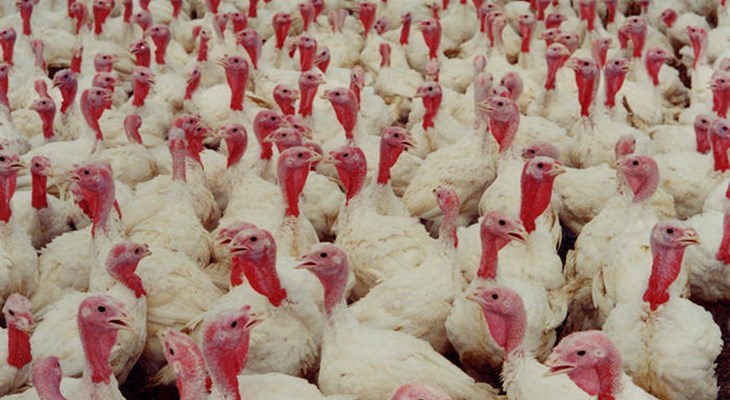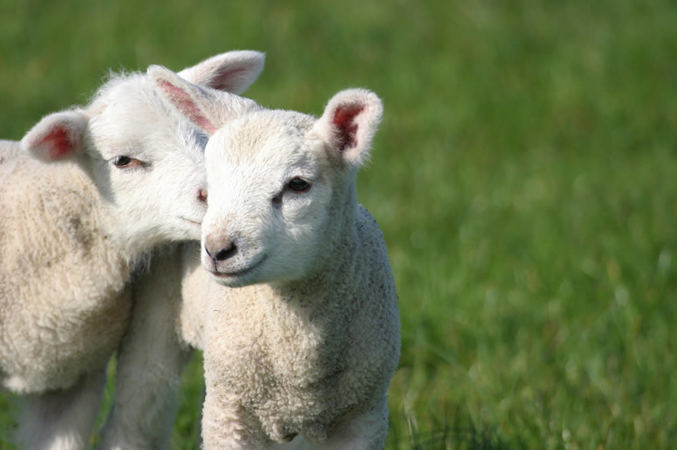Good animal welfare depends on three components:
- Physical well-being
- Mental well-being
- Natural living.
In intensive turkey farms all three of these are compromised by overcrowding in filthy conditions, barren environments, mutilations and rapid growth. Turkeys also suffer injury and stress through rough handling during catching, transport and slaughter.
Welfare issues for turkeys
Turkeys are naturally inquisitive birds, and spend much of their time exploring and foraging for food. Wild turkeys are capable of flying and running at high speeds.
Intensive production severely restricts turkeys’ natural behaviour which is bad for their mental wellbeing and keeps them in conditions which can damage their health.
Fast growth and lameness
Turkeys have been selectively bred to grow faster, reach heavier weights, and have very large breast muscles. This has led to various health problems including painful leg disorders and body system failures, e.g. heart failure.
Selective breeding has also limited their behaviour. Turkeys can no longer fly and often have difficulty walking and mating; they are often too heavy to mate naturally and instead females are usually artificially inseminated.
Overcrowding

Overstocking barns means birds have difficulty moving around to reach food and water, and may be unable to avoid aggressive individuals. Their environment also deteriorates faster; litter becomes wet from the birds’ waste and releases ammonia into the air. These conditions often cause birds to suffer from painful skin and foot sores and eye and respiratory problems.
Combined with poor ventilation, overcrowding can lead to very high temperatures in the shed, causing the birds discomfort and heat stress.
Spread of disease
Intensive production methods are stressful for turkeys, and when animals are stressed they are more susceptible to disease. Additionally, overcrowding increases the risk of infectious diseases spreading.
The 2007 outbreak of avian flu in the UK had devastating effects on the turkey farming industry.
Aggression, lighting and beak trimming

Keeping turkeys in overcrowded and barren environments increases aggression between the birds, which leads to stress and injuries. To reduce aggression, turkeys are often kept in low lighting conditions to make them less active. However this can lead to eye abnormalities and blindness.
Feather-pecking and cannibalism are problems in intensive turkey farming. With very little in their environment to investigate and explore, turkey often begin to peck each other. To reduce injury from feather-pecking, when turkeys are a day old, part of their beaks are cut off. This is procedure is painful but performed without anaesthetic.
Slaughter
Turkeys often suffer broken legs and wings (and may even die) from rough handling during catching, crating and transportation to the slaughterhouse. When they arrive, they may suffer further pain and distress by being hung upside down on a shackle line by their feet before being slaughtered.
Turkeys struggle in their shackles before being stunned (typically via electrical water bath), which can cause bone dislocations and fractures. In the UK, the law allows them to be hung for up to 3 minutes before stunning, causing considerable suffering. In some countries, this may be longer. Flapping their wings while on the shackle line means they sometimestouch the electrified bath before their heads enter the water, causing painful electric shocks.
Following stunning, to render birds unconscious to pain, the birds are killed by cutting a combination of veins/arteries in their necks. However some may not be stunned properly and regain consciousness before their throats are cut. If the main arteries are not effectively severed they may even be conscious as they are plunged into the scalding tank.
During winter, turkeys are often killed in smaller ‘seasonal’ slaughterhouses or in on-farm facilities. This is sometimes done by neck dislocation, which may be carried out by untrained staff and without pre-stunning. In some instances, they may have their throats cut without pre-stunning. This is illegal in the EU, though exceptions are made for religious slaughter.
Turkeys are sometimes plucked within seconds of neck dislocation when they may still be alive and conscious.
There are alternative methods of turkey rearing and slaughter that cause less suffering.
Higher welfare alternatives for turkeys
There is no turkey-specific legislation protecting turkeys in the EU, but there are legal marketing standards and assurance schemes that improve turkey welfare in less intensive systems.
Higher welfare indoor systems
Turkeys are reared in barns with a more space than in intensive systems. Perches and straw bales are often provided, which encourages exercise and exploration. It also allows them to rest above the ground, which is more natural for turkeys and can reduce feather-pecking.
These systems usually have better air and litter quality. This reduces the risk of lameness, foot sores and eye problems.
Free-range and organic systems

These systems offer significantly higher welfare for turkeys.
Standard free-range
Turkeys are kept at lower densities in the barn, and have daytime access to an outdoor range for at least half of their lives. Access to daylight and fresh air means better eye and respiratory health. Turkeys have more space to exhibit natural behaviour and exercise, resulting in stronger, healthier legs.
Free-range systems often use slower-growing breeds which means the turkeys are less likely to suffer from the heart problems and lameness associated with fast growth rate.
Organic
In organic systems turkeys have access to an outdoor range, and are given more space per bird than in free-range systems. Small, movable houses may be used and shelter is often provided by trees and shrubs on the outside range. They are kept in much smaller group sizes; in the EU, 2500 turkeys per group is the maximum allowed. More space and outdoor access reduces stress and risk of feather-pecking.
Organic systems often use slower-growing breeds and the turkeys typically live longer (up to 5 months).
Organic turkey farm conditions
Welfare during slaughter
The shackling of turkeys while they are fully conscious is a major cause of suffering prior to slaughter. This is particularly painful for heavier birds and those with existing leg injuries. Pre-stun electric shocks and inefficient stunning before killing are also huge welfare problems.
There are alternative slaughter methods for turkeys that have the potential for higher welfare; controlled atmosphere killing (CAK) is the most humane method currently available. CAK involves the use of gas mixtures to stun (leaving them unconscious to pain) then kill the birds. Turkeys can be exposed to these gases while still inside the transport crates, which avoids the need for shackling the birds while they are still alive.
In seasonal or on-farm slaughterhouses, head-only electrical stunning should be used immediately before slaughter. At least 2 minutes should elapse before birds are plucked.

